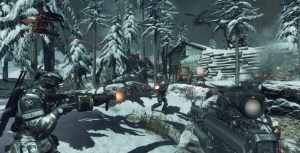GamesBeat: That’s a lot of perks.
Rubin: It is a lot of perks. Putting together your perk loadouts becomes part of your strategy, and you can do this right off the bat. Then you can remove your secondary or remove your equipment and get up to 11 perk slots.
Again, keeping that theme of customization going, we wanted to play around with game modes that offered a variety of gameplay – fast game modes, slower game modes. Small maps, the kind that people love in Call of Duty, and larger, organic maps that aren’t like anything you might have seen in Call of Duty, that have a different play style.
The whole Squads mode fed out of what we were doing with create-a-soldier and create-a-squad – modes that allow you to experience multiplayer in ways that you weren’t expecting. It’ll feel like multiplayer, and the AI has been written so that it feels like a real player. The AI will camp in corners. They’ll do a lot of things that you hate other players for doing. It makes you feel like you’re playing against people, but you get to control the experience.
We’re also adding things that don’t have any relationship, like me and my squad versus you and your squad while you’re offline. You’re at work, I’m at home playing, and I can challenge your squad. What will happen is that from your 10 squad members, you’ll pick six to populate a map, plus a game mode. Then I’ll find you on my friends list and challenge them.
A whole new strategy comes out of this where you decide the loadouts for your squad. For instance, if you decided to put your squad on a small map and loaded everyone up with sniper rifles, they probably aren’t going to do very well. You want to pay attention to the equipment, the kill streaks, everything your squad can use, and strategize the map and the mode together. Then I’ll come in with my squad and try to play against your squad and see how I do. We’ll both earn XP for multiplayer while we do that, even though you’re offline.
GamesBeat: Where do you come up with these ideas?
Rubin: Lots of weird hours in hot offices. [Laughs] It was just the idea of being able to asynchronously play against each other and have our squads do stuff while we weren’t playing.
GamesBeat: How independently do you guys operate from Treyarch? Do you not necessarily look at their advances each year?
Rubin: What it comes down to is, we’re in different cycles. Right now we’re in crunch mode, getting the game finished. We’re doing press and PR. They’re in the preproduction phase. We’re so out of sync from a production standpoint that there’s not a lot of opportunity for crossover. We’re going to ease off this game into DLC and move on to making the next game, and then they’ll be in their crunch. It just never quite allows us to work together like that.
GamesBeat: One of the things I think we saw last year was a greater accessibility on the Black Ops II side as far as multiplayer philosophies. You had the larger reticle, the designs around it. That big pink X would show up, and you would just fire, right? The shock charges, too — pro players really hated those.
Rubin: Both teams try to give to both sides. We have such a huge community that we have every type of player you could imagine. We have every type of casual player, non-casual player, hardcore player, e-sports player. We have to try to cater to everybody, which is a huge challenge. But the two studios take different routes to get to that. They’re different, and that’s a good thing. It adds a little variety to what Call of Duty has to offer.
Unless you’re a pro player, you may not notice this, but the movement is slightly slower or faster on one or the other. The health is slightly lower or higher. The pro guys notice it right away. They’ll play either. They like both. But there is definitely a philosophy difference between the two studios.
GamesBeat: These new movement features, like the contextual lean and the mantling and the knee slide. It seems like the pros would really appreciate those. They’re fancier ways to avoid somebody.
Rubin: They do add some more to your arsenal for movement through the world. It’s going to be helpful for the casual guys as well, though, because we’ve made it easy to do. It’s not like you need massive skill to be able to do this. Leaning is simple. You go up to a corner and you aim down the sights. There’s no special button. It’ll just lean out for you.
GamesBeat: This is more a development question. I just wonder how you get these things done. The resource demands seem to be multiplying. You have the PC, Xbox 360, PS3, PS4, and Xbox One. The thing that maybe works in your favor, though, that Mark Cerny has mentioned, is that everyone is familiar with x86, which will be the architecture for both the PS4 and the Xbox One. The time to get to a prototype that works is a lot shorter.
Rubin: That’s totally true. The next-gen systems will be a lot easier to develop for. If I could take my Call of Duty hat off for a second, I’m excited about the next-gen platforms, because I think indie developers — or even just small developers – will have an easier time developing for those platforms than for the previous systems. Those systems required more resources as far as code and knowledge base. They weren’t easy to work with. I’m hoping that the smaller guys will be able to make cool content on these next-gen systems more easily than they did before.
GamesBeat: You guys have bodies to throw at that problem.
Rubin: That’s the thing. I’m not worried about us. It’s more about smaller studios that don’t have Call of Duty money.
GamesBeat: You guys don’t necessarily want to double your development costs, though.
Rubin: No. Although it is getting harder and more expensive to do these bigger games. The next-gen systems definitely expand that problem. What we’ve done, instead of ballooning—Basically, we don’t want to lose our culture. Right now, what we’ve done is engage with some of our other studios, like Raven and Neversoft. Those guys have helped out for this game. It’s an interesting way to develop. Our last two games – MW3 and Ghosts – were developed that way, with the other studios helping.
VentureBeat's mission is to be a digital town square for technical decision-makers to gain knowledge about transformative enterprise technology and transact. Learn More



